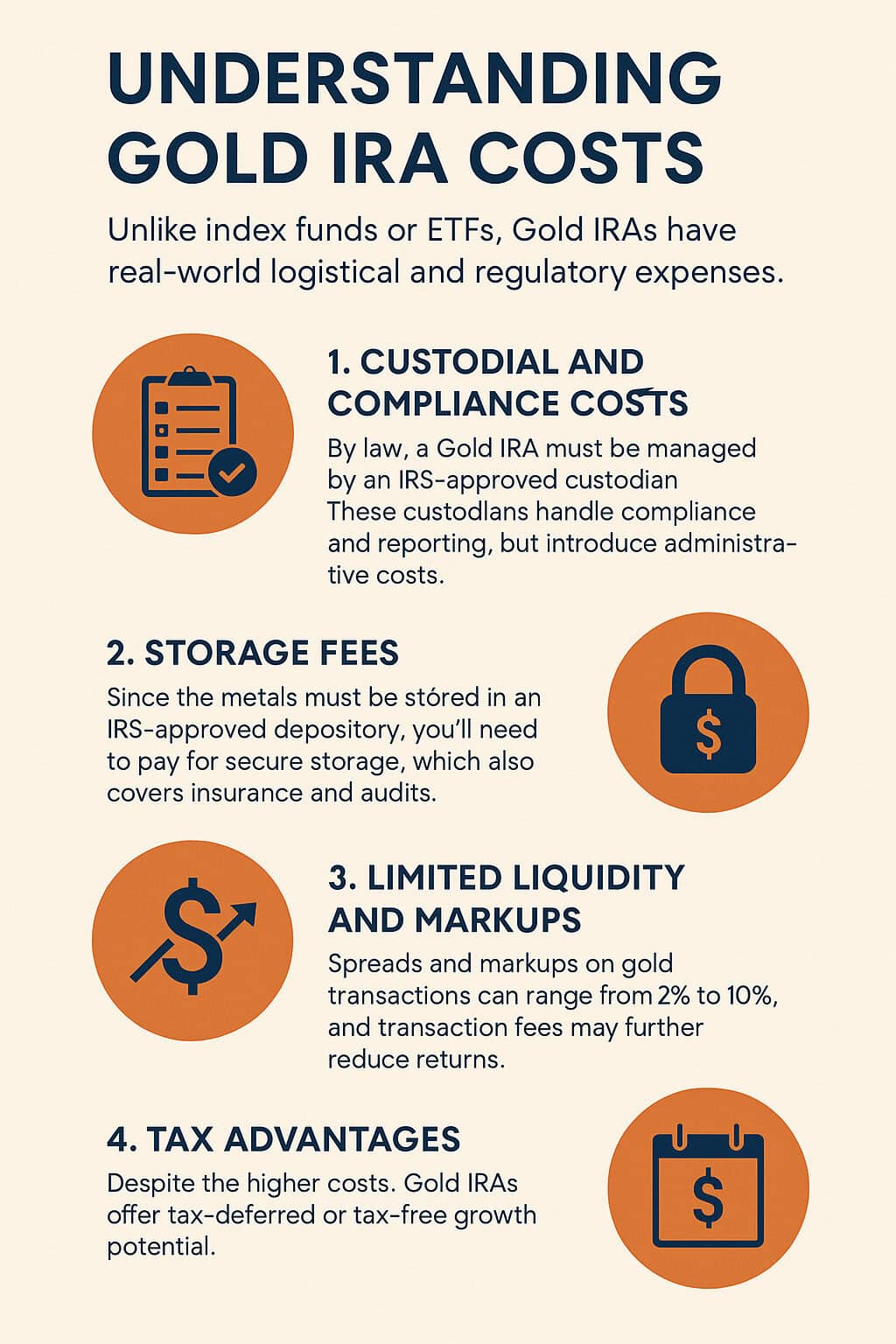Are Gold IRA Costs Still Worth It in 2026? A Cost-Benefit Analysis Amid Market Uncertainty

Market volatility continues to shape the investment landscape in 2026, prompting many investors to revisit safe assets, such as gold, as a means to protect their wealth and their savings.
As a result, Gold IRAs in particular have regained attention as a long-term strategy for protecting investors against inflation, currency depreciation, and geopolitical risk. Considering the actual geopolitical tensions, this is something you want to take into consideration.
Yet despite the enduring appeal of physical gold, one key question remains: are the costs of a Gold IRA still justified? As we mentioned in many past articles, the entire operation does not come for free and involves third parties... Therefore, is it still ok for you as an investor?
Rather than simply listing fees, this article takes a closer look at whether those costs are sensible in today’s financial environment, providing a grounded analysis for investors who want to make informed, strategic decisions.

Key Takeaways:
- Gold IRAs come with real, recurring costs
- Unlike ETFs or index funds, Gold IRAs involve custodial, storage, and transaction fees that can add up over time.
- In 2025, economic uncertainty is driving renewed interest
High inflation, growing sovereign debt, and currency instability are pushing more investors toward physical gold for long-term security. - Costs may be justified—but only in specific scenarios
A Gold IRA can make strategic sense for long-term wealth preservation and inflation hedging, but not for short-term or small-scale investors. - Fee compression is happening, but transparency still matters
Some providers now offer reduced storage or setup fees, yet hidden markups and unclear pricing remain a risk without proper due diligence.
Understanding Gold IRA Costs: A Quick Recap
A Gold IRA is a self-directed retirement account that lets you have approved precious metals (like Gold, Silver, Platinum and Palladium) instead of traditional paper assets like stocks or bonds.
As said already, these accounts come with a specific set of costs that you have to be aware of.
Common Gold IRA expenses include account setup fees, annual maintenance or custodian charges, storage fees for keeping the metals in IRS-approved facilities, transaction fees for buying or selling, and dealer markups on the price of gold.
Depending on the provider and the size of your investment, annual costs typically range from $200 to over $500, excluding the markup on the metals themselves that you have to add on top of it.
Over time, these fees can cut into your returns unless the investment delivers strong long-term value and serves a clear strategic purpose.
To sum up:
• Account setup fees
• Annual custodian or maintenance fees
• IRS-approved storage fees
• Transaction fees on buying or selling metals
• Dealer markups on gold premiums
Depending on the provider and the investment size, total annual costs can range from $200 to over $500, excluding premiums on the gold itself.
These recurring and upfront costs can partially erode returns, unless properly justified by long-term performance and strategic benefits.
2026: The Economic Backdrop for Gold IRAs
The current economic landscape in 2026 is defined by a combination of persistent and overlapping risks.
In fact, Central banks are still struggling to control inflation without pushing economies into recession.
Furthermore, Public debt levels in both the United States and the European Union have reached historic highs, fueling concerns among the investors about long-term currency stability.
Moreover, Equity markets, while showing occasional gains, remain fragile, propped up more by speculative momentum than by solid fundamentals. Meanwhile, gold has climbed to new nominal highs, surpassing $2,500 per ounce in the second quarter of 2025.
In this environment, gold continues to serve as a credible hedge within a diversified portfolio.
But the key question for retirement investors is whether the costs associated with a Gold IRA strengthen that defensive role or gradually eat away at its benefits.
What Are You Really Paying For?
Contrarily to index funds or ETFs, Gold IRAs rely on real-world logistics and strict regulatory oversight.
In fact, that’s where most of the costs come from. Understanding what those fees actually cover is for you essential before deciding if they’re worth your investment or not.
1. Custodial and compliance costs
By law, a Gold IRA must be managed by an IRS-approved custodian. These custodians handle all the necessary reporting, maintain regulatory compliance, and ensure the account stays within legal boundaries. While their role is essential, it introduces administrative costs that traditional IRAs typically avoid.
2. Storage fees
Since the metals must be stored in an IRS-approved depository, you’ll need to pay for secure storage. You can usually choose between segregated storage, where your gold is held separately, or commingled storage, where it’s pooled with others.
The former is more expensive, but offers greater control.
These fees also include insurance and regular audits. They don’t add value directly, but they’re part of the cost of safeguarding the physical asset.
3. Limited liquidity and markups
Buying or selling gold through a retirement account is not as straightforward as trading stocks. There are spreads and markups to account for, often ranging from 2% to 10%, depending on the product and provider.
You may also face transaction fees. Altogether, these elements can limit flexibility and chip away at your returns.
4. Tax advantages
Despite the higher costs, Gold IRAs still benefit from the same tax-deferred or tax-free growth you get with traditional or Roth retirement accounts.
That’s a significant upside, as long as the long-term performance makes up for the extra expenses along the way.

When Gold IRA Costs Are Worth It
There are situations where the costs of a Gold IRA aren’t just acceptable, they’re a logical part of a broader strategy.
Hedging against long-term inflation
If inflation remains elevated, say, above 4%, over the next decade, the real value of traditional savings can erode quickly. In that case, the ability of gold to preserve purchasing power may far outweigh the cumulative fees.
Protection against fiat currency risk
As confidence in central banks and fiat currencies continues to weaken, holding physical gold outside the traditional banking system becomes a form of insurance. For many, that peace of mind is worth paying for.
Wealth preservation at scale
For investors with large retirement balances, the relative impact of annual fees is minimal. A well-structured Gold IRA can provide diversification without dragging too heavily on overall portfolio performance.
When Gold IRA Costs Are a Burden
That said, these accounts aren’t suited for everyone. In some cases, the fees can become a real obstacle.
Short time horizon
If you plan to access the funds within five years, the combination of annual fees, storage costs, and gold markups may outweigh any potential benefit.
Small accounts
With a lower initial investment, under $10,000, for example, fixed costs can take a large bite out of any gains. The account might simply not have enough scale to justify the expense.
Simpler alternatives exist
If your goal is to track the price of gold rather than take physical ownership, ETFs or gold-backed mutual funds may offer a more cost-effective and liquid alternative.
Trends in 2026: Are Gold IRA Costs Going Down?
There are clear signs that competition is starting to lower costs across the Gold IRA industry.
More custodians are entering the market, prompting some providers to offer flat-rate storage, free account setup, or reduced annual fees.
Others have begun partnering with bullion dealers to reduce markups on physical gold.
This is good news for investors, but caution is still warranted. Some firms compensate for lower advertised fees with hidden costs, such as unclear pricing spreads or bundled services that increase the total expense. Transparency remains essential.
Always ask for a detailed breakdown of every cost before opening an account.
Are Gold IRA Costs Still Justified in 2026?
In conclusion, Gold IRA costs are real, and they’re not insignificant.
But we have to clarify that doesn’t make them unreasonable. These expenses cover critical elements: compliance, storage, and security that come with owning physical assets in a retirement account.
What matters is whether those costs align with your financial goals. If you're looking to protect long-term purchasing power, hedge against systemic risks, and preserve wealth through uncertain times, the price may be worth paying.
On the other hand, if your focus is on short-term growth, low fees, or passive investing, there are likely more efficient ways to gain exposure to gold.
In 2026, more than ever, the value of Gold IRA costs comes down to one question: what exactly are you trying to protect and how much are you willing to pay to protect it?
check out our
Latest Articles...
Author

Ignazio Di Salvo
Founder
I have a background in Economics and Business Administration from Bocconi University and a formation in Digital Marketing. I am passionate about investments and I founded BestGoldMoney.com to help individuals make smarter decisions when investing in gold, silver, and other precious metals.
BestGoldMoney.Com
At Best Gold Money, we simplify the complexities of investing in precious metals. Our platform offers comprehensive insights, reviews, and reliable recommendations to help you make informed decisions about investments in precious metals.
We focus on providing valuable educational resources, expert analysis, and up-to-date information on the best practices for securing your financial future.
As part of our commitment to transparency, we participate in affiliate marketing programs, ensuring that we only endorse products and services we trust.